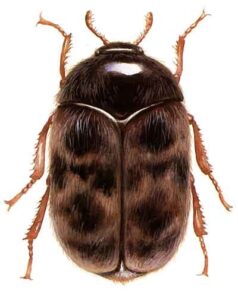-
-
- Khapra Beetles or Trogoderma
General Description
· The adult is 1.6 -1.8 mm long. The body is brown, and the chest is reddish-brown. The body is covered with soft fluff and this allows it to glide between the grains. The antennae are yellow, and consisting of 10 segments. · The small, fast-moving larva is orange-yellow, with a brown halo on the last three abdominal rings. It is 3 mm long. The body is covered by long hair.
· The pupa is a larva-like structure and remains within the last larval skin.
 Credit: USDA
Credit: USDALife Cycle and Common Characteristics
- The female lays 35-126 eggs between the cracks of the grain without giving them a glue substance, as in other insects, and lays them individually, or puts them in the cracks of the walls of the stores.
- Incubation of eggs from 5-12 days in the summer.
- The growth of the larva is completed within 20 days at 40°C and 40 days at 25°C.
- The larva overwinters in the cracks in the walls.
- The larva molts 4-14 times (depending on the amount of food).
- The larva has the ability to live for a year without food.
- The larvae enter dormancy in the cracks of the walls of the storage area, and this depends on the exposure of larvae to low temperatures and their exposure to high or low humidity.
- All stages are resistant to heat and drought and can withstand a temperature of 45°C.
- The larva can live in a relative humidity of less than 2%.
- The larva lives in empty warehouses for 4 years without food.
- There are 10 generations per year, one generation per year, or one generation over a year (depending on the environmental conditions).
Damage and Economic Implications
- They live on grain products such as flour, groats, pasta, and biscuits. They multiply on castor seeds and cotton. A type of them has been found that lives on all animal products, especially wool.
- The larva and the adult insect feed on wheat and corn grains, destroying and polluting the grains.
-



